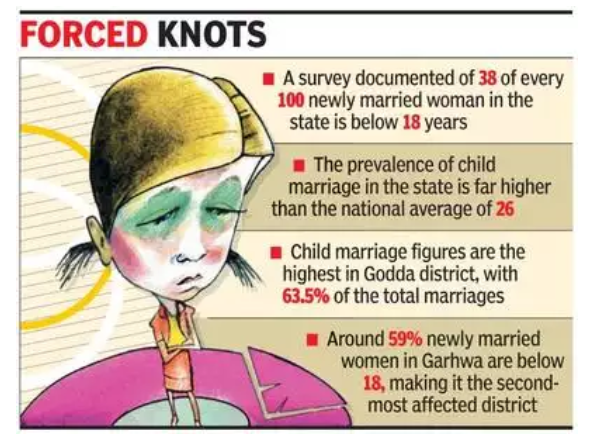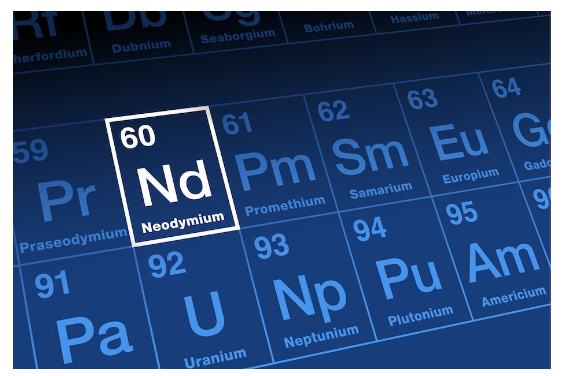Friday, 29th December 2023
UAPA Designates Hurriyat Chief's Organization Unlawful
In News: The Ministry of Home Affairs (MHA) announces the unlawful status of the Muslim League Jammu Kashmir (Masarat Alam faction).

Unlawful Activities Prevention Act (UAPA), 1967: An Overview
- Introduction
- Enacted in 1967, the UAPA serves as India's primary counter-terrorism legislation, aimed at curbing unlawful and terrorist activities that threaten the nation's integrity and sovereignty.
- Prohibited Activities
- The UAPA targets various activities, including aiding and abetting terrorists, funding terrorism, inciting anti-national sentiments, and engaging in other unlawful acts against the state.
- Key Provisions
- Granting extensive powers to the Central Government, the UAPA allows for the designation of organizations as terrorist entities and prescribes penalties for involvement in their activities.
- Notably, these provisions apply to both Indian and foreign nationals, even if offenses occur outside India.
- Timeline and Special Court
- The UAPA stipulates a maximum of 180 days for filing a charge sheet after arrests, with investigations to be completed within 90 days.
- Failure to meet this deadline grants the accused eligibility for default bail. The act establishes special courts for the purpose of conducting trials.
- Sanction to Prosecute
- Section 45 mandates that no court can take cognizance of UAPA offenses without prior sanction from the central or state government or an authorized officer.
- The sanction must be granted within a specified time after an independent review of evidence by the competent authority.
- Crucial Sections
- Several sections of the UAPA, including Section 13 (Punishment for unlawful activities), Section 16 (Punishment for terrorist acts), Section 17 (Punishment for raising funds for terrorist acts), Section 18 (Punishment for organizing terrorist camps), and Section 22 (Punishment for threatening witnesses), outline specific offenses and corresponding penalties.
- 2019 Amendment
- The UAPA underwent amendments in 2019, expanding its scope.
- Changes included empowering the government to designate individuals as terrorists, requiring NIA approval for property seizure in NIA-led investigations, and adding the International Convention for Suppression of Acts of Nuclear Terrorism (2005) to the list of treaties.
Masarat Alam: Who is He?
- Masarat Alam, successor to the late Syed Ali Shah Geelani and current chairman of the Hurriyat Conference, leads the Muslim League Jammu Kashmir. Notably, Alam played a prominent role in organizing anti-India protests in the Valley in 2010.
- Arrested under the Jammu and Kashmir Public Safety Act (PSA), he was released in 2015 but has remained in detention for almost 13 years.
Source: TH
PM JANMAN: Support for Vulnerable Tribal Groups
In News: On November 29, the Union Cabinet gave its nod to the Pradhan Mantri Janjati Adivasi Nyaya Maha Abhiyan (PM JANMAN).
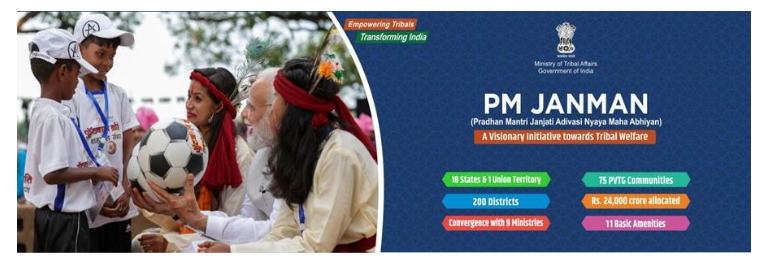
Particularly Vulnerable Tribal Groups (PVTGs): Overview
- Introduction
- PVTGs represent the most vulnerable segment among tribal groups, initially identified as "Primitive Tribal Groups" (PTG) by the Dhebar Commission in 1960-61.
- The category was later renamed Particularly Vulnerable Tribal Groups (PVTGs) in 2006.
- Numbers and Distribution
- In 1975, the Government of India designated 52 tribal groups as PVTGs based on the Dhebar Commission's recommendations.
- Presently, there are 75 such groups spread across 22,544 villages in 18 states and one Union Territory, totaling approximately 28 lakh individuals.
- Odisha has the highest concentration, exceeding 2.5 lakh PVTG members.
- Distinct Characteristics
- PVTGs share common characteristics, including stagnant or declining populations, pre-agricultural technology, extremely low literacy levels, and economies at a subsistence level.
- Population sizes vary significantly among groups, ranging from under 1,000 to over 1 lakh.
- Challenges in Development
- Severely marginalized due to isolation and distinct socio-economic and cultural traits, PVTGs face challenges such as limited access to basic services, social discrimination, vulnerability to displacement, and inadequate political representation.
- Mainstream society often overlooks their traditional knowledge, and stereotypes persist.
- Government Schemes for PVTGs
- Government initiatives, including the PVTG Development Plan, Pradhan Mantri Janjatiya Vikas Mission (PMJVM), and others, aim for holistic tribal area development.
- These schemes focus on education, healthcare, livelihood opportunities, and the preservation of traditional knowledge.
- Other Measures
- Various measures, such as Eklavya Model Residential Schools, Forest Rights Act 2006 for land titles, and support through the Scheduled Castes and Scheduled Tribes (Prevention of Atrocities) Act 1989, contribute to education, self-governance, and protection against discrimination.
PM-JANMAN: A Different Approach
- Proper Identification and Recognition
- Criticism of outdated criteria for identifying PVTGs led to the government's initiative to create a Human Development Index specifically for them.
- The participatory bottom-up approach abandons a one-size-fits-all strategy, involving PVTGs in decision-making.
- Livelihood Promotion
- The scheme emphasizes customised strategies, providing skills training, resources, and implementing the Forest Rights Act to secure access to forest resources.
- Traditional technologies are encouraged for sustainable development.
- Health, Nutrition, and Education
- Outreach strategies, such as Mobile Medical Health Units, are crucial for healthcare in remote areas. Education accessibility is enhanced by incorporating culture and language into the curriculum and training teachers about PVTG cultural contexts.
- Infrastructure Development
- Guidelines for infrastructure schemes have been relaxed to accommodate the unique habitation patterns of PVTGs, ensuring improved access to housing, water, sanitation, electricity, and connectivity.
Source: IE
MGNREGS Scheme - Edukemy Current Affairs
In News: In the fiscal year 2023-24, the Mahatma Gandhi National Rural Employment Guarantee Scheme (MGNREGS) has experienced a notable increase in women's involvement, reaching an unprecedented high.

Women's Participation Trends in MGNREGA: An Analysis
Women Participation Trends
- Gradual Increase
- Over the last decade, women's participation in MGNREGA has steadily risen, reaching 59.25% from 53.19% during the 2020-21 Covid-19 outbreak.
- Regional Disparities
- Southern states like Kerala, Tamil Nadu, Puducherry, and Goa exhibit high women's involvement, exceeding 70%, while northern states such as Uttar Pradesh and Madhya Pradesh lag behind at around 40%.
- Recent Improvements
- Despite historical disparities, states like Uttar Pradesh, Madhya Pradesh, and Lakshadweep have shown recent improvements in women's participation rates in the ongoing financial year.
Rural Labor Force Trends
- Beyond MGNREGS
- The Periodic Labour Force Survey (PLFS) indicates a substantial surge in the Female Labor Force Participation Rate (LFPR) in rural areas, rising from 18.2% in 2017-18 to 30.5% in 2022-23.
- Female unemployment rates have concurrently decreased from 3.8% to 1.8% during the same period.
MGNREGA Scheme Overview
- Introduction
- MGNREGA, initiated in 2005 by the Ministry of Rural Development, is one of the world's largest work guarantee programs.
- Legal Guarantee
- It provides a legal guarantee of 100 days of employment in every financial year to adult members of rural households willing to engage in unskilled manual work at the minimum wage.
- Active Workers
- As of 2023-24, there are 14.32 crore active workers.
- Major Features
- Legal Guarantee
- The cornerstone of MGNREGA ensures that rural adults can request and must receive work within 15 days; otherwise, an "unemployment allowance" is mandated.
- Priority for Women
- The scheme prioritizes women, aiming for at least one-third of beneficiaries to be women who have registered and requested work.
- Social Audit
- Section 17 mandates a social audit of all works executed under MGNREGA.
- Legal Guarantee
- Implementation Agency
- Monitoring
- The Ministry of Rural Development, in collaboration with state governments, monitors the entire implementation of the scheme.
- Monitoring
- Objective
- Poverty Alleviation
- MGNREGA aims to improve the purchasing power of rural people, offering semi or unskilled work to those below the poverty line and bridging the gap between the rich and poor.
- Poverty Alleviation
Achievements of 2022-23
- Households Employed
- In 2022-23, 11.37 crore households availed employment.
- Person-Days Generated
- A total of 289.24 crore person-days employment was generated, with significant proportions for women, Scheduled Castes (SCs), and Scheduled Tribes (STs).
Challenges with Scheme Implementation
- Funds Dispersal
- Delays and insufficiency in funds dispersal, leading to delays in wage payments, have impacted the effectiveness of MGNREGA.
- Caste-Based Segregation
- Significant variations in delays by caste, with SC and ST workers facing more challenges than non-SC/ST workers.
- Ineffective Role of PRI
- Panchayati Raj Institutions (PRIs) lack autonomy, hindering the effective implementation of MGNREGA.
- Incomplete Works
- There is a delay in completing works, irregular inspection of projects, and concerns about the quality of work and asset creation.
- Fabrication of Job Cards
- Issues related to fake job cards, inclusion of fictitious names, missing entries, and delays in making entries pose challenges.
Way Forward
- Consistent Fund Flow
- Ensuring a consistent fund flow to states and implementing agencies while leveraging digital tools for transparent, timely wage payments.
- Focus on Exclusion Errors
- Identifying areas where marginalized SC and ST families are missing out on MGNREGA benefits.
- Empower Councils
- Empowering State and Central Employment Guarantee Councils for informed decisions, incorporating public participation through assemblies, civil society, and worker unions.
|
UPSC Previous Year Questions Prelims (2011) Q. Among the following who are eligible to benefit from the “Mahatma Gandhi National Rural Employment Guarantee Act”? (a) Adult members of only the scheduled caste and scheduled tribe households Ans: (d) Exp:
|
Source: IE
Dark Energy - Edukemy Current Affairs
In News: A fragile equilibrium exists in the composition of the universe's energy, with various forms of matter and radiation intricately balanced.

Understanding Dark Energy in the Universe: An Overview
About Dark Energy
- Dark energy, a mysterious and elusive form of energy, constitutes a significant portion of the universe's total energy content.
- It plays a crucial role in the observed accelerated expansion of the cosmos, with approximately 68% of the universe attributed to dark energy, while dark matter makes up around 27%.
- In contrast, all observable matter on Earth constitutes less than 5%.
Key Characteristics of Dark Energy
- Invisible Force Driving Expansion
- Dark energy serves as an unseen force responsible for the universe's accelerated expansion.
- Unlike gravity, which pulls objects together, dark energy acts as a repulsive force, pushing galaxies away from each other.
- Space Dynamics
- Dark energy challenges the idea of space as a void, presenting it as a dynamic, stretchable medium that responds to the presence of energy.
- Unique Contributions to Expansion
- Different forms of energy, including matter, radiation, and dark energy, contribute uniquely to the non-uniform expansion of the universe.
- Balancing Act
- Dark energy dominates the universe's energy budget, influencing the overall rate at which space expands.
- Maintaining a delicate balance with other forms of energy is essential for cosmic stability.
Implications of Dark Energy
- Significance for the Observable Universe
- The amount of dark energy holds significant implications for the observable universe.
- An excess of positive energy could result in galaxies moving away faster than light, limiting visibility to nearby regions.
- Conversely, excessive negative energy might lead to a universe collapse.
- Diluteness Across the Universe
- Despite its dominance, dark energy is incredibly dilute across the vastness of the universe, posing questions about its nature and distribution.
Possible Explanations for Dark Energy
- Property of Space
- Einstein's gravity theory suggests that "empty space" can possess its own energy, not diluted as space expands, causing accelerated expansion.
- Quantum Theory of Matter
- The quantum theory of matter proposes that "empty space" is filled with temporary particles, forming and disappearing continually.
- Fifth Fundamental Force
- Speculative theories suggest a fifth fundamental force, termed "quintessence," to explain dark energy.
- However, none of these theories have been conclusively proven, rendering dark energy the "most profound mystery in all of science."
|
UPSC Previous Year Questions Prelims (2012) Q. Which of the following is/are cited by the scientists as evidence/evidence for the continued expansion of the universe?
Select the correct answer using the codes given below: (a) 1 and 2 Ans: (a) Exp:
|
Source: TH
Pantoea Tagorei - Edukemy Current Affairs
In News: A groundbreaking discovery by researchers at Visva-Bharati University unveils a novel bacterial species, Pantoea Tagorei, with the potential to revolutionize agricultural methods.
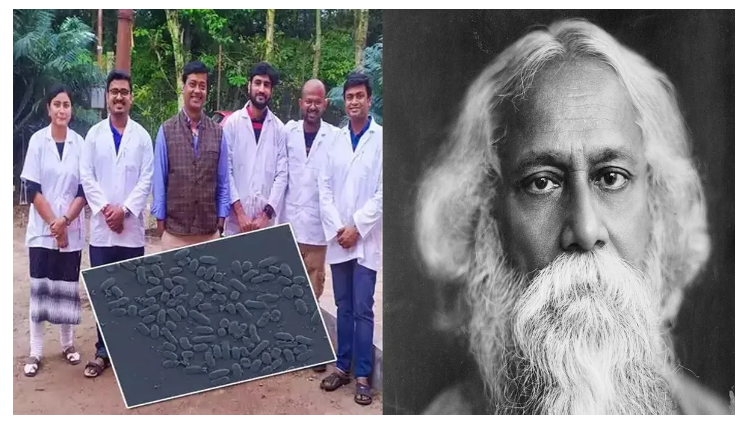
Unlocking Agricultural Potential: Pantoea Tagorei's Role as a Biofertilizer
- Overview
- Pantoea Tagorei bacteria, belonging to the genus Pantoea within the Enterobacteriaceae family, have notable characteristics and applications.
- Habitat and Isolation
- Pantoea bacteria, including Pantoea Tagorei, can be found in diverse environments such as water, soil, humans, animals, and plants.
- Plant Growth-Promoting Abilities
- Described as a plant growth-promoting bacteria, Pantoea Tagorei exhibits impressive capabilities in enhancing the cultivation of various crops, including paddy, pea, and chili.
- Nutrient Extraction and Solubilization
- The bacteria efficiently extracts potassium from the soil, contributing to enhanced plant growth.
- Additionally, it facilitates the solubilization of both potassium and phosphorus, nitrogen fixation, and overall nutrient availability for plants.
- Impact on Crop Yield and Food Security
- The positive effects on plant growth suggest the potential for increased crop yield, addressing critical issues related to food security.
- Reducing Dependency on Commercial Fertilizers
- Pantoea Tagorei plays a crucial role in enhancing soil nutrient availability, potentially reducing the reliance on commercial fertilizers.
- This aspect makes it a cost-effective approach to sustainable agriculture, positioning it as a potential biofertilizer.
|
UPSC Previous Year Questions Prelims (2021) Q. With reference to Madanapalle of Andhra Pradesh, which one of the following statements is correct? (a) Pingali Venkayya designed the tricolour Indian National Flag here. (b) Pattabhi Sitaramaiah led the Quit India Movement of Andhra region from here. (c) Rabindranath Tagore translated the National Anthem from Bengali to English here. (d) Madame Blavatsky and Colonel Olcott set up headquarters of Theosophical Society first here. Ans: (c)
Prelims (2010) Q. Which feature of some species of blue-green algae helps promote them as bio-fertilizers? (a) They convert atmospheric methane into ammonia which the crop plants can absorb readily (b) They induce the crop plants to produce the enzymes which help convert atmospheric nitrogen to nitrates (c) They have the mechanism to convert atmospheric nitrogen into a form that the crop plants can absorb readily (d) They induce the roots of the crop plants to absorb the soil nitrates in larger quantities Ans: (c) Exp:
|
Source: TH
Sensor for Formalin Detection in Fish
In News: Researchers at Guwahati University, Assam, have innovated a novel sensor comprising a metal oxide-reduced graphene oxide (metal oxide-rGO) composite.
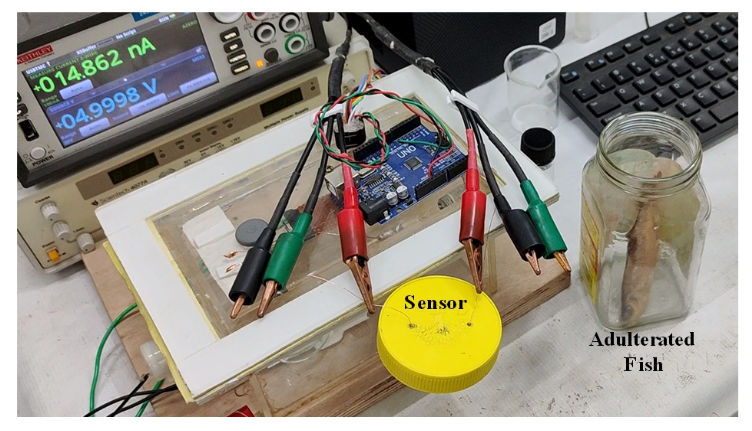
Key Facts About the Metal Oxide-rGO Sensor
- Overview
- The sensor utilizes a composite of Graphene Oxide (GO) and tin oxide-reduced graphene oxide (rGO-SnO2) to detect formalin in adulterated fishes, offering a low-cost, non-invasive, and selective solution to prevent food adulteration.
- Need for Innovation
- Traditional formalin sensors for fish either rely on expensive electrochemical-based methods or less costly but invasive colorimetric-based approaches.
- These methods often struggle with issues related to low-level and selective detection.
- Working Procedure
- Challenges with GO
- The oxidized form of graphene, GO, initially poses challenges due to low electrical conductivity.
- Enhanced Composite
- Scientists addressed GO's limitations by developing a composite, tin oxide-reduced graphene oxide (rGO-SnO2), with improved properties.
- Composite Benefits
- rGO provides high solution processability and ease of chemical modification, while tin oxide contributes high stability and sensitivity to low concentrations of formaldehyde.
- Effective Sensing
- The sensor, crafted from tin oxide (SnO2) decorated Reduced graphene oxide (rGO), demonstrates effective sensing of formaldehyde vapor at room temperature.
- Optimized Combination
- Leveraging the strengths of rGO in detecting toxic gases and SnO2 in formaldehyde detection, the combination maximizes their individual capabilities.
- Challenges with GO
Breakthrough in Food Adulteration Prevention
- The ongoing lab process for designing the prototype marks a potential breakthrough in preventing food adulteration, showcasing the sensor's significance in ensuring food safety for consumers.
Source: PIB
Palna Scheme - Edukemy Current Affairs
In News: Under the 'Palna' scheme, the Ministry of Women and Child Development aims to establish 17,000 creches within Anganwadi centers throughout India
About Palna Scheme
- This undertaking seeks to offer secure day-care facilities, fostering the cognitive, nutritional, and health advancement of children.
- With a rising women workforce participation rate, reaching 37% in 2022, the expansion of creches reflects a dedicated endeavor to bolster women's support while nurturing the development of upcoming generations.
- In July 2022, the Ministry of Women and Child Development overhauled the National Creche Scheme, rebranding it as the Palna Scheme under 'Mission Shakti.'
- This transformation introduced Anganwadi cum Creches and reclassified existing creches from the previous scheme as Stand Alone Creches.
Source: PIB
Justice Sanjiv Khanna Nominated as NALSA Executive Chair
In News: The Executive Chairperson of the National Legal Services Authority (NALSA) has been nominated by the President, with the senior-most judge of the Supreme Court, Justice Sanjiv Khanna, selected for the position.
About the National Legal Services Authority (NALSA)
Introduction
- NALSA, established under the Legal Services Authorities Act, 1987, is dedicated to offering free legal services to the marginalized sections of society and facilitating Lok Adalats for amicable dispute resolution.
Primary Objective
- The paramount goal of NALSA is the expeditious disposal of cases to alleviate the burden on the judiciary.
Leadership
- The Chief Justice of India serves as the patron-in-chief of NALSA.
- The second senior-most judge of the Supreme Court of India assumes the role of the Executive Chairman.
- NALSA is headquartered at the Supreme Court of India in New Delhi.
Organizational Structure
- In each State, a State Legal Services Authority exists.
- In every High Court, a High Court Legal Services Committee is constituted.
- District Legal Services Authorities and Taluk Legal Services Committees are established at the district and taluk levels, aligning with NALSA's policies and directions.
Legal Literacy Programs
NALSA, through State Legal Services Authorities, conducts legal literacy programs to enhance legal awareness.
Free Legal Services
The spectrum of free legal services includes:
- Payment of court fees and related charges in legal proceedings.
- Provision of legal representation in court.
- Obtaining certified
- copies of orders and documents.
- Preparation of appeals and related documents in legal proceedings.
Eligibility for Free Legal Services
- Women and children
- SC/ST members
- Industrial workmen
- Victims of mass disasters, violence, natural calamities, and industrial disasters.
- Disabled individuals
- Persons in custody
- Those with an annual income not exceeding Rs. 1 lakh (Rs. 5,00,000 for the Supreme Court Legal Services Committee).
- Victims of human trafficking or begging.
Constitutional Provisions
- Article 39A emphasizes free legal aid for the economically weaker sections.
- Articles 14 and 22(1) obligate the State to ensure equality and justice.
Key Facts about Lok Adalats
- An alternative dispute resolution mechanism.
- Settles or compromises disputes pending in court or at the pre-litigation stage.
- Conducted by NALSA and other legal services institutions.
- Holds statutory status under the Legal Services Authorities Act, 1987.
Appeal and Fees
- The Lok Adalat's decision is deemed a decree, final and binding.
- No appeal lies against the Lok Adalat's award.
- No court fee is payable for matters filed in Lok Adalats.
Nature of Cases for Lok Adalats
- Any pending case before any court.
- Disputes not presented before any court but likely for future litigation.
- Matters related to non-compoundable offences are not settled in Lok Adalats.
Source: TI
Wang’s Garden Lizard- Edukemy Current Affairs
In News: China has recently identified a new reptile species, naming it Wang's Garden Lizard.

About Wang’s Garden Lizard
- Species Identification
- Wang's Garden Lizard is a newly identified species of iguana.
- Scientific Name: Calotes wangi
- Distribution
- Found in subtropical evergreen broad-leaved forests and tropical monsoon forests in southern China and northern Vietnam.
- Primarily located in mountainous areas, hills, plains on forest edges, arable land, shrub lands, and urban green belts.
- Conservation Status
- Currently not considered threatened, but certain areas face habitat fragmentation.
- Distinctive Features
- Measures less than 9 cm in length.
- Notable feature includes an orange tongue.
- Active at the forest edge, demonstrating a tendency to rush into bushes or climb tree trunks when endangered.
- During the night, it rests on sloping shrub branches, sleeping close to the branches.
- Diet and Activity
- Consumes a diverse range of insects, spiders, and other arthropods.
- Active from April to October annually, extending to March to November or longer in tropical regions.
- Cultural Significance
- Apart from their ecological role, their bodies are utilized for medicinal purposes, and the lizards are also consumed as food.
Source: SN
Eurasian Otter - Edukemy Current Affairs
In News: In a noteworthy discovery, a team of researchers recently identified the presence of a Eurasian otter in the Chinnar Wildlife Sanctuary in Idukki, marking the first recorded instance in Kerala.

About the Eurasian Otter
- Species Classification
- The Eurasian Otter is a semi-aquatic carnivorous mammal native to Eurasia.
- Scientific Name: Lutra lutra
- Geographical Distribution
- Among Palearctic mammals, it boasts one of the broadest distributions, ranging from Ireland to China and extending south to Southeast Asia.
- Populations are found throughout Europe, North Africa, and Asia.
- In India, it is present in northern, northeastern, and southern regions.
- Habitat Variety
- Inhabits diverse environments such as streams, rivers, lakes, freshwater and peat swamp forests, ocean shores, rice fields, fjords, caves, and terrestrial habitats near waterways.
- In the Indian subcontinent, it thrives in cold hills and mountain streams.
- Physical Features
- Possesses a lengthy body with a thick tail and short legs.
- Exhibits a brown upper coat and cream-colored underbelly.
- Sensitive whiskers around the snout aid in prey detection.
- Dual layers of fur include a dense, waterproof outer coat and a warm inner layer.
- Displays acute senses of sight, smell, and hearing.
- Primarily an elusive, solitary otter, but occasional sightings of family groups, comprising a mother and her offspring, occur.
- Diet Diversity
- Maintains a varied diet encompassing fish, crustaceans, amphibians, and occasionally reptiles, birds, eggs, insects, and worms.
- Conservation Status
- IUCN Status: Near Threatened
- Wildlife Protection Act, 1972: Schedule II
- CITES Listing: Appendix I
Source: TH
Harmony in Farming: Natural Power from Plough to Plate
In News: The article delves into the obstacles confronting natural farming and underscores the imperative of exploring alternative markets to advocate for and advance the cause of natural farming.
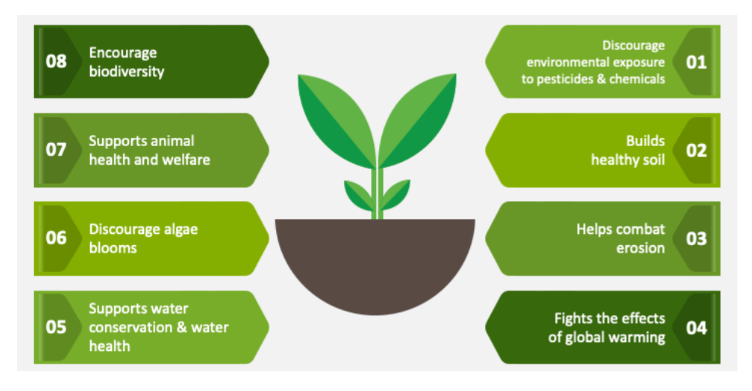
What is Natural Farming?
The Concept
Natural farming is a method devoid of chemicals, utilizing local resources and traditional practices. Rooted in agroecology, it integrates crops, trees, and livestock, incorporating beneficial microorganisms to enhance soil quality.
What are the Benefits of Natural Farming?
- Environmental Benefits
- Healthy Soil
- Techniques like composting foster soil fertility, improving water retention and nutrient availability.
- Water Conservation
- Methods like mulching and drip irrigation reduce soil moisture loss, crucial for sustainable water management.
- Reduced Pollution
- Substituting chemical inputs minimizes soil, water, and atmospheric pollution, safeguarding ecosystems and human health.
- Climate Change Mitigation
- Natural farming practices contribute to lower carbon footprints, with healthy soil acting as a carbon sink.
- Healthy Soil
- Farmer Benefits
- Reduced Costs
- Local resources and on-farm inputs lead to lower production costs, improving overall farmer profitability.
- Improved Farm Resilience
- Techniques promote soil health and biodiversity, enhancing farm stability against extreme weather events.
- Enhanced Farmer Health
- Eliminating exposure to harmful chemicals safeguards the well-being of farmers.
- Reduced Costs
- Consumer Benefits
- Safer Food
- Natural farming produces chemical-free food, ensuring safer consumption.
- Improved Food Quality
- Naturally grown food may have higher levels of beneficial nutrients, contributing to improved consumer health.
- Support for Sustainable Agriculture
- Choosing natural food indirectly supports a more sustainable and ethical agricultural system.
- Safer Food
What are the Challenges Related to Natural Farming?
- Limited Market
- Lack of differentiated markets and standards hinder farmers from obtaining premium prices for natural farming products.
- Lower Initial Yields
- Building healthy soil ecosystems takes time, resulting in lower yields initially compared to conventional methods.
- Lack of Awareness and Training
- Limited knowledge and access to training programs hinder farmers from adopting natural farming techniques.
- Availability and Affordability of Organic Inputs
- High costs of organic inputs discourage farmers from adopting natural farming practices.
- Pest and Disease Management
- Ecological methods for pest control may be less effective in the short term, requiring increased vigilance.
What Measures Should be Taken to Promote Natural Farming?
- Developing Alternative and Differentiated Markets
- Integrating NF produce into the Public Distribution System (PDS) ensures a stable market.
- Collaborating with Farmer Producer Organizations (FPOs) enhances production efficiency.
- Effective Implementation of Certification
- The Participatory Guarantee System (PGS-India) and self-certification tools like CETARA-NF ensure quality without third-party certification.
- Incentives and recognition are crucial for effective implementation.
- Developing Awareness
- Creating awareness among farmers and consumers is essential for transitioning to natural farming.
- Reliable certification can contribute to the growth of the niche market.
- Exploring Alternate Markets
- Integration of NF produce into the PDS, existing cooperative networks, mid-day meal programs, and dedicated haats can expand alternative markets.
- Consumer Cooperatives
- Establishing consumer cooperatives in urban/peri-urban areas supports the local procurement of NF produce.
- Developing Awareness
- Increasing awareness among farmers and consumers about the benefits of natural farming is critical for widespread adoption.
Conclusion
Promoting natural farming requires a comprehensive approach, encompassing market development, certification, awareness-building, and collaboration among stakeholders. Such measures can contribute to sustainable agriculture, benefitting farmers, consumers, and the environment.
|
UPSC Previous Year Questions Prelims (2021) Q. How is permaculture farming different from conventional chemical farming?
Select the correct answer using the code given below: (a) 1 and 3 Ans: (b) Prelims (2018) Q. With references to organic farming in India, consider the following statements:
Which of the statements given above is/are correct? (a) 1 and 2 only Ans: B Mains (2021) Q. What are the present challenges before crop diversification? How do emerging technologies provide an opportunity for crop diversification? Mains (2019) Q. How has India benefited from the contributions of Sir M. Visvesvaraya and Dr. M. S. Swaminathan in the fields of water engineering and agricultural science respectively? |
Source: BL
Share the article
Edukemy’s Current Affairs Quiz is published with multiple choice questions for UPSC exams
MCQ
Get Latest Updates on Offers, Event dates, and free Mentorship sessions.

Get in touch with our Expert Academic Counsellors 👋
FAQs
UPSC Daily Current Affairs focuses on learning current events on a daily basis. An aspirant needs to study regular and updated information about current events, news, and relevant topics that are important for UPSC aspirants. It covers national and international affairs, government policies, socio-economic issues, science and technology advancements, and more.
UPSC Daily Current Affairs provides aspirants with a concise and comprehensive overview of the latest happenings and developments across various fields. It helps aspirants stay updated with current affairs and provides them with valuable insights and analysis, which are essential for answering questions in the UPSC examinations. It enhances their knowledge, analytical skills, and ability to connect current affairs with the UPSC syllabus.
UPSC Daily Current Affairs covers a wide range of topics, including politics, economics, science and technology, environment, social issues, governance, international relations, and more. It offers news summaries, in-depth analyses, editorials, opinion pieces, and relevant study materials. It also provides practice questions and quizzes to help aspirants test their understanding of current affairs.
Edukemy's UPSC Daily Current Affairs can be accessed through:
- UPSC Daily Current Affairs can be accessed through Current Affairs tab at the top of the Main Page of Edukemy.
- Edukemy Mobile app: The Daily Current Affairs can also be access through Edukemy Mobile App.
- Social media: Follow Edukemy’s official social media accounts or pages that provide UPSC Daily Current Affairs updates, including Facebook, Twitter, or Telegram channels.

